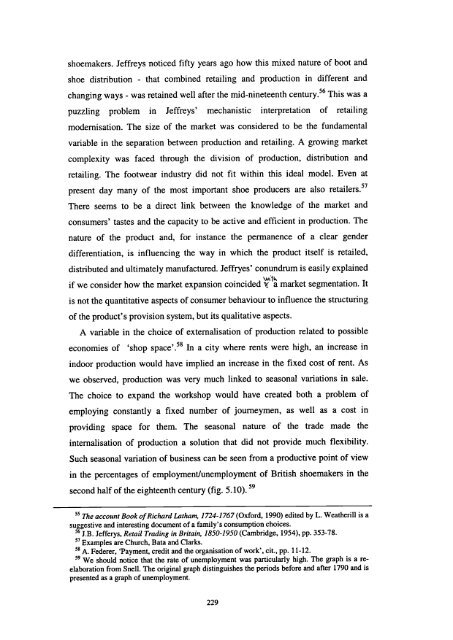The Boot and Shoe Trades in London and Paris in the Long Eighteenth Century
The Boot and Shoe Trades in London and Paris in the Long Eighteenth Century
The Boot and Shoe Trades in London and Paris in the Long Eighteenth Century
You also want an ePaper? Increase the reach of your titles
YUMPU automatically turns print PDFs into web optimized ePapers that Google loves.
shoemakers. Jeffreys noticed fifty years ago how this mixed nature of boot <strong>and</strong><br />
shoe distribution - that comb<strong>in</strong>ed retail<strong>in</strong>g <strong>and</strong> production <strong>in</strong> different <strong>and</strong><br />
chang<strong>in</strong>g ways - was reta<strong>in</strong>ed well after <strong>the</strong> mid-n<strong>in</strong>eteenth century. 56 This was a<br />
puzzl<strong>in</strong>g problem <strong>in</strong> Jeffreys' mechanistic <strong>in</strong>terpretation of retail<strong>in</strong>g<br />
modemisation. <strong>The</strong> size of <strong>the</strong> market was considered to be <strong>the</strong> fundamental<br />
variable <strong>in</strong> <strong>the</strong> separation between production <strong>and</strong> retail<strong>in</strong>g. A grow<strong>in</strong>g market<br />
complexity was faced through <strong>the</strong> division of production, distribution <strong>and</strong><br />
retail<strong>in</strong>g. <strong>The</strong> footwear <strong>in</strong>dustry did not fit with<strong>in</strong> this ideal model. Even at<br />
present day many of <strong>the</strong> most important shoe producers are also retailers.57<br />
<strong>The</strong>re seems to be a direct l<strong>in</strong>k between <strong>the</strong> knowledge of <strong>the</strong> market <strong>and</strong><br />
consumers' tastes <strong>and</strong> <strong>the</strong> capacity to be active <strong>and</strong> efficient <strong>in</strong> production. <strong>The</strong><br />
nature of <strong>the</strong> product <strong>and</strong>, for <strong>in</strong>stance <strong>the</strong> permanence of a clear gender<br />
differentiation, is <strong>in</strong>fluenc<strong>in</strong>g <strong>the</strong> way <strong>in</strong> which <strong>the</strong> product itself is retailed,<br />
distributed <strong>and</strong> ultimately manufactured. Jeffryes' conundrum is easily expla<strong>in</strong>ed<br />
if we consider how <strong>the</strong> market expansion co<strong>in</strong>cided market segmentation. It<br />
is not <strong>the</strong> quantitative aspects of consumer behaviour to <strong>in</strong>fluence <strong>the</strong> structur<strong>in</strong>g<br />
of <strong>the</strong> product's provision system, but its qualitative aspects.<br />
A variable <strong>in</strong> <strong>the</strong> choice of extemalisation of production related to possible<br />
economies of 'shop space'. 58 In a city where rents were high, an <strong>in</strong>crease <strong>in</strong><br />
<strong>in</strong>door production would have implied an <strong>in</strong>crease <strong>in</strong> <strong>the</strong> fixed cost of rent. As<br />
we observed, production was very much l<strong>in</strong>ked to seasonal variations <strong>in</strong> sale.<br />
<strong>The</strong> choice to exp<strong>and</strong> <strong>the</strong> workshop would have created both a problem of<br />
employ<strong>in</strong>g constantly a fixed number of journeymen, as well as a cost <strong>in</strong><br />
provid<strong>in</strong>g space for <strong>the</strong>m. <strong>The</strong> seasonal nature of <strong>the</strong> trade made <strong>the</strong><br />
<strong>in</strong>ternalisation of production a solution that did not provide much flexibility.<br />
Such seasonal variation of bus<strong>in</strong>ess can be seen from a productive po<strong>in</strong>t of view<br />
<strong>in</strong> <strong>the</strong> percentages of employment/unemployment of British shoemakers <strong>in</strong> <strong>the</strong><br />
second half of <strong>the</strong> eighteenth century (fig. 5.10).<br />
<strong>The</strong> account Book of Richard Latham, 1724-1 767 (Oxford, 1990) edited by L. Wea<strong>the</strong>rill is a<br />
suggestive <strong>and</strong> <strong>in</strong>terest<strong>in</strong>g document of a family's consumption choices.<br />
56<br />
J.B. Jefferys, Retail Trad<strong>in</strong>g <strong>in</strong> Brita<strong>in</strong>, 1 850-1 950 (Cambridge, 1954), pp. 353-78.<br />
are Church, Bata <strong>and</strong> Clarks.<br />
58 A. Federer, 'Payment, credit <strong>and</strong> <strong>the</strong> organisation of work', cit., pp. 11-12.<br />
We should notice that <strong>the</strong> rate of unemployment was particularly high. <strong>The</strong> graph is a reelaboration<br />
from Snell. <strong>The</strong> orig<strong>in</strong>al graph dist<strong>in</strong>guishes <strong>the</strong> periods before <strong>and</strong> after 1790 <strong>and</strong> is<br />
presented as a graph of unemployment.<br />
229


